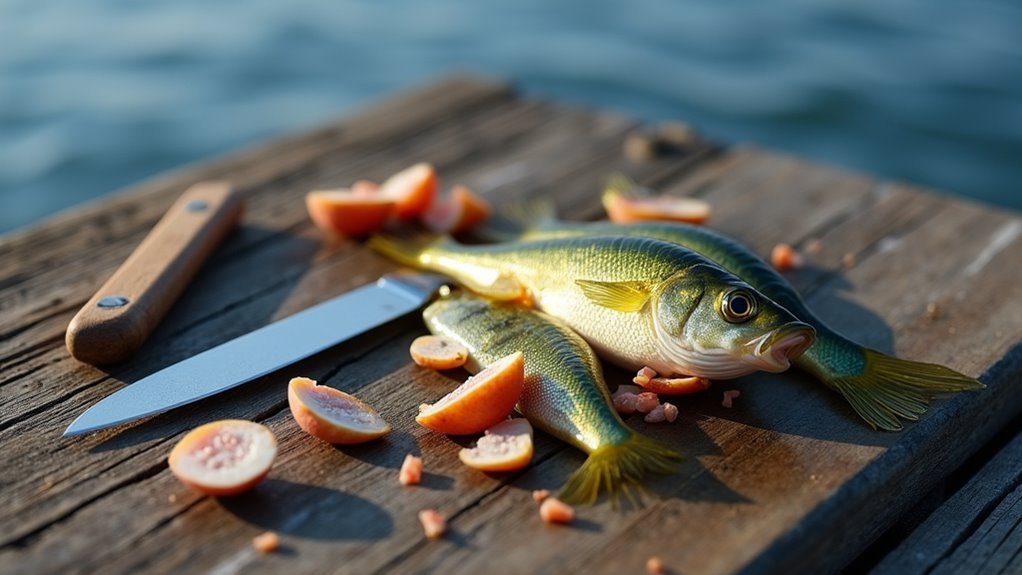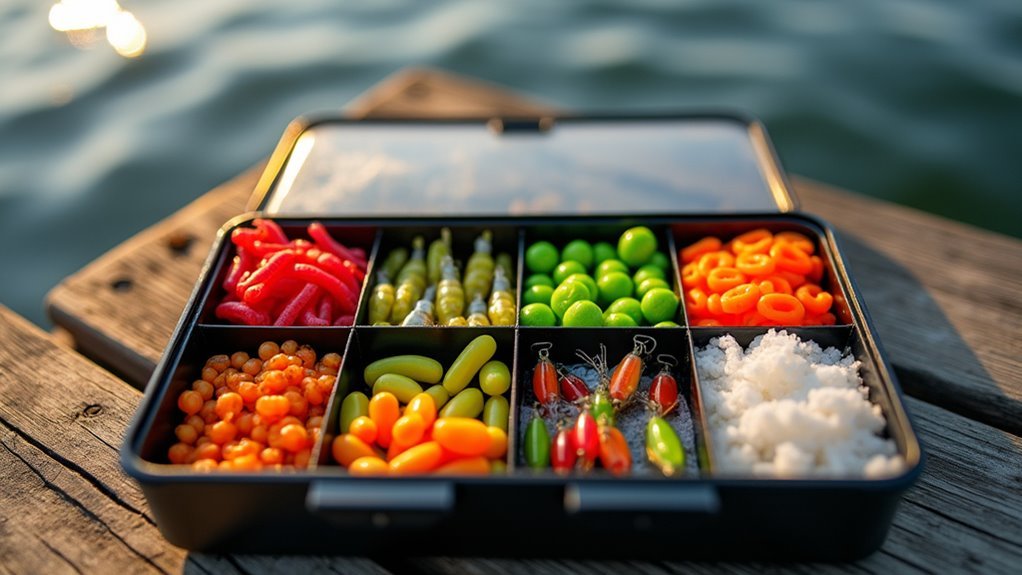For yellow perch success, you’ll want to match your bait to their opportunistic feeding habits. Small 2-3 inch minnows like emerald shiners work great for larger perch, while nightcrawlers (cut into pieces) are versatile year-round options. During ice fishing, try waxworms or small soft plastics in white or chartreuse. Dawn and dusk offer peak feeding times, so position your bait near the bottom. The right seasonal selection will greatly improve your catch rate.
Understanding Yellow Perch Feeding Habits

When it comes to successfully catching yellow perch, understanding their feeding habits is absolutely essential. These fish are opportunistic feeders with appetites that change seasonally and as they grow.
Smaller perch primarily target insects and tiny crustaceans, while their larger cousins become more predatory, often hunting minnows and even smaller perch. I think this explains why different baits work better at different times of year.
As perch grow larger, their prey preferences shift from tiny invertebrates to baitfish—explaining the seasonal effectiveness of different lures.
You’ll notice perch are most active during dawn and dusk, though they’ll feed throughout the day.
Perhaps the most important thing to remember is that they typically feed near the bottom, so that’s where your bait should be!
Top Live Minnows That Catch More Perch
Live minnows are probably the most reliable bait you can use for yellow perch fishing.
When it comes to consistently catching these tasty fish, small 2-3 inch minnows tend to outperform most other options, especially for larger perch.
Emerald and spottail shiners are particularly effective in the Great Lakes region, I think because they closely match what perch naturally feed on.
Gold shiners and fathead minnows work well too, depending on what’s available locally.
Remember to check regulations before using any live fish as bait – rules vary widely between different waters, perhaps more than you’d expect.
Effective Worms and Insects for Every Season
While minnows certainly have their place in a perch angler’s tackle box, worms and insects frequently outperform them throughout different seasons.
I’ve found that nightcrawlers are perhaps the most versatile option – they work year-round and can be used whole or cut into smaller pieces depending on the perch’s mood.
Don’t overlook smaller options like red worms and waxworms.
The latter are particularly effective during ice fishing when perch become more finicky.
And if you’re looking for something different, try grasshoppers in summer or leeches in spring. Their natural wiggling motion is sometimes irresistible to hungry perch.
Cut Bait Strategies for Trophy Perch

Although minnows and worms attract plenty of perch, serious trophy hunters often turn to cut bait for consistently landing jumbo yellow perch.
I’ve found that 1-inch strips cut from local fish species work best, especially if you leave the skin attached for better hook retention.
Yellow perch are surprisingly cannibalistic, so using smaller perch fillets might be your best bet.
Bluegill, crappie, and white bass can be equally effective, particularly when cut fresh.
Remember to check local regulations though – some waters restrict certain bait types.
Perhaps the most overlooked secret is using fish eyes or intestines when nothing else seems to work.
Crustaceans and Amphibians as Premium Perch Bait
Crayfish and tadpoles deserve special attention in your perch fishing arsenal, perhaps more than any other natural bait options.
When perch are being finicky, these natural prey items often trigger strikes when nothing else works. I’ve found their lifelike movement in water absolutely irresistible to hungry perch.
- Soft-shelled crayfish – Most effective when available, typically after molting
- Small whole crayfish – Hook through the tail for natural presentation
- Spring tadpoles – Abundant during spawning season, easy to net
- Live presentation – Keep them lively for more action than dead options
Artificial Alternatives When Live Bait Isn’t Available
Not every fishing trip allows for the luxury of live bait. When your minnow bucket runs dry, there are effective artificial alternatives that’ll still help you catch yellow perch.
Berkley Gulp! minnows and scented worms often outperform unscented options, mimicking both appearance and smell. I’ve found that white, chartreuse, or yellow colors typically work best, perhaps because they stand out in murky water.
You might also try tipping small jigs with Crappie Nibbles or similar dough baits. They’re surprisingly effective, especially during winter when perch are less aggressive.
Sometimes I think the simplest setup – a tiny soft plastic on a light jig head – is actually the most reliable when live bait isn’t an option.
Seasonal Bait Selection Guide for Year-Round Success

Yellow perch feeding patterns change dramatically with the seasons, making your bait selection equally important throughout the year.
I’ve found that what works in July often fails in December, and adapting is essential for consistent success.
- Spring (Post-Spawn) – Focus on small minnows and nightcrawlers when perch move to shallow waters.
- Summer – Try crayfish and shad in deeper, cooler waters where perch retreat.
- Fall – Use larger minnows as perch feed aggressively to fatten up.
- Winter – Small, compact baits like waxworms or mealworms work best under ice.
Perhaps the most overlooked factor is local availability – use what’s naturally present in your lake.
Legal Considerations and Regional Bait Differences
Before you head out with your favorite perch bait, it is vital to understand that fishing regulations can vary dramatically from one state or province to another. I’ve learned this the hard way – what’s perfectly legal in Michigan might get you a hefty fine in Minnesota.
| Region | Live Minnow Rules | Cut Bait Restrictions | Notable Exceptions |
|---|---|---|---|
| Great Lakes | Generally allowed | Few restrictions | VHS concerns in some areas |
| Northwest | Often restricted | Usually permitted | Native species protection |
| Northeast | Seasonal limitations | Permitted year-round | Varies by watershed |
| Midwest | Allowed with permits | Few restrictions | Invasive species laws apply |
Perhaps check local regulations before your trip – they’re updated yearly and sometimes even seasonally.
Frequently Asked Questions
How Do I Store Live Bait to Keep It Fresh Longer?
Keep live bait in aerated containers at cool temperatures. Change water daily for minnows. Store worms in refrigerated moss bedding. Don’t overcrowd bait and remove dead ones promptly.
Can I Use Saltwater Baits for Yellow Perch Fishing?
You can use saltwater baits for yellow perch, but freshwater options are more effective. If you’re trying saltwater baits, choose smaller ones similar to their natural freshwater prey.
Which Bait Colors Attract Perch in Murky Water Conditions?
In murky water where vision blurs like morning fog, you’ll want chartreuse, orange, or white baits that cut through the darkness. Bright colors create contrast that perch can’t resist when visibility’s limited.
How Should I Modify My Baiting Technique in Extreme Weather?
During extreme weather, you’ll need to slow down your presentation. In cold, use smaller baits with less movement. In heat, try deeper waters with scented options that attract sluggish perch.
What’s the Most Cost-Effective Way to Source Quality Perch Bait?
Did you know 80% of perch anglers overspend on bait? You’ll save money by raising your own red worms, collecting local minnows with a trap, or cultivating mealworms at home.